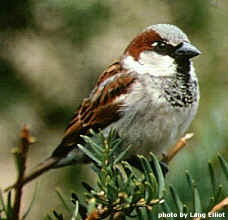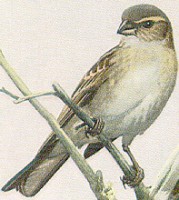The house or English sparrow, a non-native species, has flourished in
the Americas since its human introduction in the mid-19th century.
Background
The house sparrow, Passer domesticus , is a native of Eurasia and Africa
that long ago learned to live closely with humans. It was deliberately
introduced to the Americas in 1854 by homesick immigrants from Europe
who wanted a reminder of their homelands. Because of human introduction,
the house sparrow has an almost worldwide distribution.
Description
The house sparrow is an abundant sparrow-like bird. They have generally
brown plumage and are about 5.75 inches (14.5 cm) total length. Males
have a striped back, the crown of the head is gray while the back of the
neck is brown. Mature males are also characterized by their black bib.
Females and juveniles are brown with striped backs, unspotted buff
bellies and a buff eye stripe.
Range and Habitat:
The house sparrow is common throughout the United States, but is most
abundant near people and their structures. In some situations house
sparrow populations can reach true pest proportions.
Food:
The young are fed on insects until they are almost full grown. Young
birds are often seen following and begging for food from their parents
for up to two weeks after they leave the nest.
Adults primarily feed on seeds and grain. They are one of the dominant
species at bird feeders--where they feed on white, red, and German
golden millet; and canary seed found in commercial wild bird seed mix.
House sparrows will eat other types of seed as well: including
wildflower seeds, sunflower, and safflower seeds, and tree seeds
especially from sweet gum. They will also feed on grain products such as
bread crumbs and livestock feed.
The willingness of the house sparrow to feed close to people can cause
problems at picnic shelters and outdoor restaurants.
Nesting and Reproduction:
The nest of the house sparrow is an untidy mass of dried grass, leaves,
pine straw, string, paper, and feathers. The nests are usually built in
bird houses, soffits and attics, behind signs, behind or above pipes and
ductwork entering buildings, in crevices into wall voids, behind shake
siding, in or on the rafters of large buildings like warehouses, barns
and livestock buildings and in the forks of branchy trees. The nests
usually fill the crevices they are located in and may be as large as 1
to 1.5 feet (30 to 46 cm) in diameter.
House sparrows can breed year-round in the southern states, but most
clutches are laid between March and September. They can have several
clutches per year. Each clutch contains 3 to 5 heavily speckled white
eggs. The incubation period is 10-14 days. The young remain in the nest
until they are almost the size of their mother; about 15 days.
Problems and Solutions:
Aesthetic and Economic Problems
The primary problems associated with house sparrows are caused by their
close proximity to people. The unsightly nests and white droppings are
generally considered undesirable. The dry plant material in the nest can
be a fire hazard, especially inside lighted signs. When birds occupy a
warehouse and defecate on stored goods this becomes an expensive
nuisance if retailers refuse to accept contaminated goods.
The uric acid (white material) in bird droppings is both unsightly and
can damage the finish on automobiles. Large populations of sparrows in
agricultural situations can cause economic losses due to consumption and
contamination of livestock feed.
Health-related Problems:
The most common problem associated with house sparrows is bird mites
invading the living space of the house during or after the nesting
season. Bird mites--like northern fowl mite and tropical fowl mite--will
bite humans and cause a small pustule, similar to a chigger bite. House
sparrows are also important reservoirs and vectors of reintroduction of
fowl mites into treated poultry houses. Sparrow nests can also be a
source of stick-tight fleas, soft ticks, bed bugs, and dermestid
(carpet) beetles.
House sparrows have been associated with numerous disease organisms
transmissible to humans and livestock. These include the following: Nine
bacterial diseases including salmonellosis (Salmonella food poisoning)
and tuberculosis; the fungal disease Sarcosporidiosis ; three protozoan
diseases including Toxoplasmosis and Coccidiosis; Chlamydiosi s; nine
viral diseases including eastern equine, St. Louis, Venezuelan, and
western equine encephalitis, Newcastle disease and fowl pox of poultry,
and transmissible gastroenteritis of swine (hog cholera); three species
of parasitic nematodes of poultry Tetramares (2 sp.) and Acuaria
spiralis ; and the parasitic fluke of poultry, Collyriculum faba . House
sparrows are generally a more serious disease vector to livestock,
especially poultry and egg producers, than to humans. However the
presence of house sparrows in areas where food is prepared or people
eat, such as picnic areas and outdoor restaurants, should be a cause for
concern about the spread of Salmonella bacteria.
RETURN TO TOP
